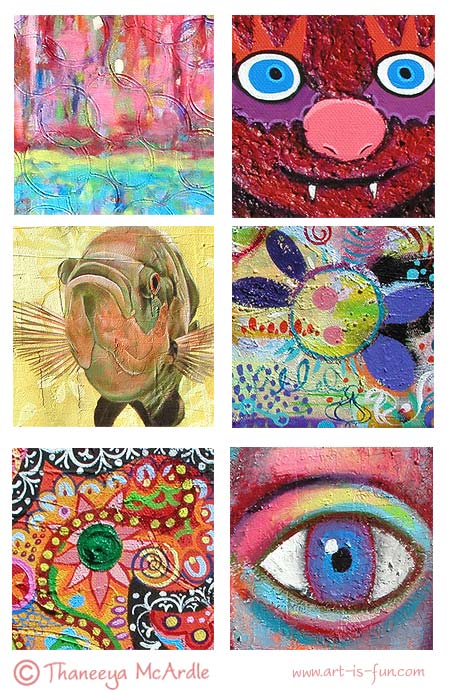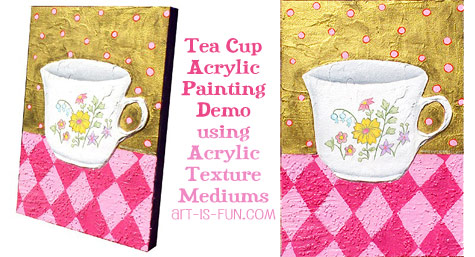Acrylic Texture Mediums
Acrylic texture mediums are a fun, easy way to add a whole new dimension to your acrylic paintings! On this page I'll explain what these textured acrylic mediums are and how to use them.
What are acrylic texture gels and mediums?
As their name suggests, acrylic texture mediums enhance the tactile quality of your painting. They are also known as acrylic texture gels or gel mediums, depending on the brand. The 4 main brands that make acrylic texture mediums are Liquitex, Golden, Pebeo, Winsor & Newton (these link to Blick Art Materials, and if you make a purchase we get a small commission that helps support this site).
What can you do with acrylic texture mediums?
Let me show you a few quick examples of what you can do with acrylic texture gels. The images below are all close-ups of my acrylic paintings that were made with texture mediums or gels. Can you see the texture?
Acrylic texture mediums can create really cool effects that would be difficult or impossible to create otherwise (that is, by using just plain acrylic paint). Here are just some ways that you can use textured acrylic mediums to add oomph and pizazz to your work:
You can create impasto effects, with dramatic peaks and valleys
You can sculpt the acrylic medium before it has dried on the canvas
You can use woodcutting tools to carve into the acrylic medium after it has dried on the canvas
You can create staining effects by painting over the acrylic medium with a wash of acrylic paint
You can use a rotary tool with an engraving attachment to etch fine designs into dried mediums such as molding paste
You can make acrylic skins
There are many, many ways to apply and use acrylic texture mediums - the sky's the limit! With so many possibilities, this article only touches the surface of what's possible. The rest is up to you!
Learn how to use a mask to create a 3-D effect with acrylic texture mediums in this step-by-step tutorial!
Acrylic texture mediums are a great addition to non-traditional styles of painting (such as abstracts, Pop Art, etc), although with a bit of inspiration you could also come up with creative ways to use these mediums to enhance more "traditional" art styles (like realist still lifes, landscapes or portraits).
For instance, you could use an acrylic medium to highlight or draw attention to certain areas of a painting, such as adding texture to the bark of a tree or the sand on a beach.
If you make a purchase via the links below we receive a small commission, which helps support this site.
In my painting above, the realistically-painted iguana is sitting on top of an abstract background. The area behind him was covered with Liquitex Light Modeling Paste, and the area below him was covered with a mixture of Liquitex Ceramic Stucco Gel and Liquitex Natural Sand Texture.
How do you use acrylic texture mediums?
Acrylic texture mediums can be applied to surfaces like canvas, paper, wood, etc - anything that can normally accept acrylics.
To use acrylic texture mediums, first prime your surface with gesso. You can read more about gesso here.
When the gesso is dry, you are ready to begin. There are 2 basic ways to apply acrylic texture mediums:
Liquitex Light Modeling Paste applied onto canvas straight from the jar (top) and after having been mixed with green acrylic paint and then applied to the canvas (bottom)
straight out of the jar and onto your canvas, or
scooped from the jar to your palette - to be thinned with water or medium, or mixed with other mediums or paints - and then applied to the canvas.
Which method you prefer will depend on whether you want to add color or mix it with other mediums. If you want to mix it with other mediums or paints, it's a lot easier to do this on your palette first, and then apply the mixture to the canvas once you're happy with it (rather than try to mix everything together on your canvas).
With that said, there's a lot of room for experimentation when it comes to using acrylic mediums, so feel free to try out different methods of application!
Adding color to acrylic texture mediums
Acrylic mediums are translucent and will typically dry to a white or off-white if no color is added. After the medium has dried on your canvas, it forms an absorbent surface that can be painted over.
Since acrylic mediums are translucent, they will easily take on any color they are mixed with, so a little bit of acrylic paint will go a long way when mixed with a texture medium. Whether you want to add color (by mixing the medium with acrylic paint) before applying it to canvas or after it has dried is up to you, and what you want to achieve.
In addition to adding color, you can also combine acrylic texture mediums, using a few different ones in a single painting, to create different effects. You can mix them together or after the acrylic medium has dried on your canvas, you can also add more acrylic texture mediums on top.
In my painting above, the background is covered with plain Liquitex Light Modeling Paste and then painted over. On the left side, I mixed blue acrylic paint on my palette with Liquitex Light Modeling Paste and Liquitex Glass Bead Gel and then applied the mixture to the canvas.
How to apply acrylic texture mediums
There are endless ways to apply texture mediums. You can apply the texture mediums with:
palette knife - a very useful tool if you want to mix the medium with paint or other mediums on your palette before applying it to canvas. A palette knife is usually my main tool for applying texture mediums.
kitchen knife - works in a pinch if you don't have a palette knife
spatula
paintbrush
your fingers
Once it's on your canvas, you can:
spread the acrylic medium across your canvas with an old credit card or piece of cardboard
push it around with your fingers
drag a comb across it to create texture
carve into it with the end of your paintbrush or with a stick (while the medium is still damp)
embed objects into it (while the medium is still damp) - you can either leave the object in the medium permanently, or just press an object into it and remove it so that it leaves an imprint
After the medium is dry, you can:
paint over it
draw over it
add more acrylic texture mediums on top of it
carve into it using carving tools or woodcutting tools
sand it using wet sandpaper
These are just some ideas to get you started. There are so many things you can do with acrylic texture mediums, much more than I could ever list here!
In my painting above, I applied a combination of Liquitex Light Modeling Paste and Liquitex Ceramic Stucco to my canvas, and then used the wooden tip of my paintbrush to "draw" lines in the damp texture medium. After the medium dried, I painted over it.
Varnishing over acrylic texture mediums and gels
Before you varnish your painting, you want to be sure that the paint and the medium have totally dried. Depending on how much acrylic texture gel you applied, the drying process may take awhile. Thinner applications can dry in a few hours, but thicker applications can take a few days. Be aware that even if the texture gel is dry to the touch, it may still be wet or damp underneath.
Varnishing over acrylic texture mediums can be tricky, because you're not varnishing a flat, uniform surface. The varnish will need to penetrate all the peaks and valleys (large and small) to fully protect your painting. If the varnish isn't applied properly, it could cause cloudiness or foaming.
There is no single sure-fire method for varnishing over acrylic texture gels, because each painting can be so vastly different, depending on the type and amount of texture medium(s) used. Here are 2 suggestions that can help your varnishing process go more smoothly:
Use a spray varnish (buy on Blick: purchases support this site). A spray varnish, rather than a brush-on varnish, has a better chance of protecting your painting without causing cloudiness or bubbles. Be sure to use a spray varnish that is archival and non-yellowing, and follow all procedures outlined on the spray can, including safety instructions (such as varnishing in a well-ventilated area, ideally outdoors).
If you want to use a brush-on varnish, be sure to varnish slowly, covering a small amount of space at a time and analyzing the results as you go, studying the painting from various angles. Be on the lookout for tiny bubbles (foam) or a translucent milky-white cloudiness. If this occurs, stop and let the varnish dry and then take another look. Did the bubbles and cloudiness disappear? If so, it might be okay to continue. If not, try suggestion #1.
When it comes to both using acrylic texture mediums and varnishing over them, experiment first to avoid disappointment later. When you first use acrylic texture mediums or gels, approach them as an experiment so you can learn what you can do with them. You may find that you like certain mediums or gels more than others. As you experiment, you might discover new avenues you'd like to explore for a particular texture medium.
Liquitex Texture Gels
Since I mainly use the Liquitex acrylic texture mediums (called Liquitex Texture Gels), those are the ones I'll tell you more about now. Here's an overview of the range of Liquitex Texture Gels:
Light Modeling Paste - Both lightweight and thick, Light Modeling Paste creates a fun textured surface to paint over because it's so absorbent. This is one of my favorite acrylic texture mediums because it's so versatile and it's a real pleasure to paint over it when it's dry.
Ceramic Stucco Texture Gel - This is also another one of my favorites to paint over because I love the absorbent texture it creates. Ceramic Stucco Texture gel can be applied thickly or thinly. It results in a toothy surface that can accept charcoal, soft pastels, and oil pastels, in addition to acrylic paint.
Black Lava Texture Gel - This gel contains little uniform black specks and has a satin sheen. The effect of this texture gel is best noted when it is mixed with a transparent or translucent acrylic paint. Opaque acrylics tend to cover over the black specks.
Natural Sand Texture Gel - Consisting of fine sand particles, this texture gel creates a subtly textured surface. If you want large granules for dramatic effects, try the Resin Sand Coarse Texture Gel.
Glass Beads Texture Gel - This gel contains lots of tiny clear glass beads, which is cool for creating whimsical bubbly effects.
Blended Fibers Texture Gel - This texture gel looks just as it sounds, like a bunch of fibers. Blended Fibers Texture Gel can create interesting sculptural effects or be used to create a paper-like surface.
Resin Sand Coarse Texture Gel - This is more thick and coarse that the Natural Sand Texture Gel and dries to more of a concrete-like finish.
White Opaque Flakes Texture Gel - This gel creates a rather rough, irregular surface that's not very easy to paint over, so I find that mixing paint into it on the palette is the easiest way to color it. As its name suggests, this texture gel contains small opaque white flakes.
Return to the Table of Contents on the Main Acrylic page, where you'll find links to acrylic painting tutorials and detailed info about acrylic painting supplies.














